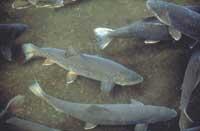Nearby caviar, unknown and scarce
2002/12/01 Mendiburu, Joana - Elhuyar Zientziaren Komunikazioa
Gaizkata ( Acipenser sturio ), supplier of caviar so appreciated in haute cuisine, is an unknown fish among us. The local fishermen don't fish, they don't look in the markets, and the caviar comes into very small boats, as if the evil put the eggs directly in the boat.
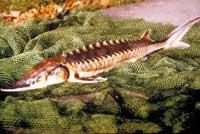
In addition, we consider caviar as a distant product, although 200 kilometers from the Basque Country, in the vicinity of Bordeaux, specifically in the rivers Dordogne and Garonne, lives, in its day, a large population that is now only composed of a few hundred.
Taking advantage of the prosperous market of caviar, sturgeon has been disappearing from its only European residence for fishing extensively and indiscriminately. Before its complete extinction, in 1982, it was declared a protected species in France and, since then, its fishing and sale is strictly forbidden.
If Gironde caviar is currently on the market, it is certainly produced in several local fish farms. At the moment, there are four or five nurseries that produce about 1,000 tons a year.
Numerous harmful activities
It was good news for the evil that in 1982 was declared a protected species, but it was not enough to repopulate these two great rivers. In fact, the other activities that have been less or more harmful than fishing continued to undergo changes in the environment.
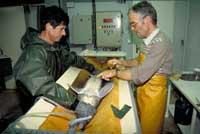
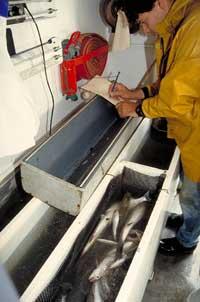
Each year he faced greater difficulties in reaching the place of reproduction. Many died before reaching the point of arrival, among other things, because the currents were more intense for channeling rivers, because the banks lose stability and the quality of the water was worsening.
As if it were not enough, the French electric company EDF built several facilities in the Dordogne and Garonne rivers in the 1950s, such as five large reservoirs in Dordogne and the Garonan Golfech nuclear power plant.
With these difficulties, only the strongest or most skilled managed to reach, with reproductive intention, the place where they were born. But what usually happens to those who have been out of the house for many years happened to them: the change was so great that they did not know their place of origin.
The sturgeon, like the salmon, prepares the brush between pebbles, since the stones protect the eggs from predators and prevent the currents from raging. However, the stone of these rivers has been extracted for years, and in addition to destroying the proper places to pose the eggs, they have covered the corners that used the suspended particles in the water to protect them. Today, even with eggs appreciated by evil, fertilisation will be minimal or null.
In addition, the complete mixture of the river bottom has released the cadmium accumulated in the sediments and has partly worsened the water quality. Cadmium is a heavy metal that, in addition to the future of evil, has endangered the production of thousands of tons of oysters from the bay of Marennes-Olé. Given that in the bay of Marennes-Oléron there are about 70% of the French oysters, it is obvious that the serious economic consequences that the prohibition of this activity would have. Aware of this danger, the extraction of the stone from the funds of the Dordogne and Garonne rivers was forbidden.
But all these prohibitions have come too late for evil. Only a few hundred copies remain, of which very few mature reproducers. In fact, males live between 14 and 15 years and females between 20 and 22 years. It is, therefore, a fish of long life —the trout lives about 10 years— and spend the years of maturation to reproduce.
Situation change plan since 1994
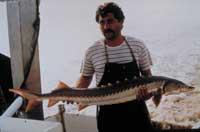
To change this situation, in 1994, Cémagref (…) launched a repopulation plan of the Dordogne and Garonne rivers. The plan is articulated in two main lines: a better knowledge of the species and a river repopulation.
In fact, we are not the only ones who know little about this species, and scientists are studying the species and its surroundings. For this purpose, they follow the population of the evil, measure the specimens captured and take close care of the state of the brushes. The second activity consists of artificial reproduction of fish farms and river repopulation. To do this, they have investigated Acipenser baeri, the Siberian species, and have managed to mix with the autochthonous, Acipenser sturio. The first fishes of Acipenser sturio born in nurseries were thrown into the rivers in 1995.
A lot of life for evil Given its Latin name ( Acipenser sturio ) or in Basque (gaizkata), it is a fish that few know, but their eggs or eggs do we know them all. After cleaning them and passing them to the salt, they become caviar that is eaten only on special days. Gaizkata, like salmon, is a migratory fish. It is born and reproduces in the river and reaches the sea to reach sexual maturity. Between March and July take the way up to the river to reach the arrabio and lay the eggs. Despite not being known among us, it presents prominent features that help identify them. It is a large fish, 2 meters long by 50-60 kilos of weight, with tail and long tip. It is also known as the king fish of the bay of Gironde. |
Published in 7K.

Gai honi buruzko eduki gehiago
Elhuyarrek garatutako teknologia




